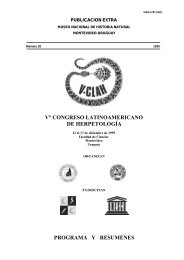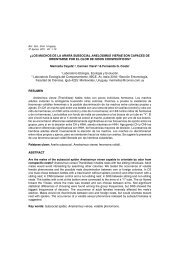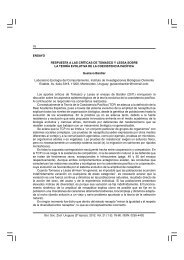Primer Congreso Uruguayo de Zoología - Sociedad Zoológica del ...
Primer Congreso Uruguayo de Zoología - Sociedad Zoológica del ...
Primer Congreso Uruguayo de Zoología - Sociedad Zoológica del ...
You also want an ePaper? Increase the reach of your titles
YUMPU automatically turns print PDFs into web optimized ePapers that Google loves.
AUTO-RALEO EN PECES ANUALES: DESENTRAÑANDO LOS MECANISMOS SUBYACENTESA LAS RELACIONES DENSIDAD-TAMAÑO CORPORALZarucki, M. & M. ArimSección <strong>Zoología</strong> <strong>de</strong> Vertebrados, Departamanto <strong>de</strong> Ecología y Evolución, Facultad <strong>de</strong> Ciencias, U<strong>de</strong>laR, Uruguay. mzarucki@gmail.comEl tamaño corporal es una propiedad fundamental <strong>de</strong> los organismos, <strong>de</strong>terminando su <strong>de</strong>manda metabólica yconsecuentemente el uso <strong>de</strong> recursos. La relación entre el tamaño corporal y la abundancia revela la partición <strong>de</strong> losrecursos entre los organismos <strong>de</strong> un ecosistema, presentando los tamaños corporales mayores menoresabundancias. Se han documentado diferentes relaciones entre el tamaño corporal y la abundancia, pero los distintosabordajes utilizados implican diferentes procesos, limitando su interpretación. El “Auto-Raleo” <strong>de</strong>scribe ladisminución en <strong>de</strong>nsidad con el aumento <strong>de</strong>l tamaño corporal promedio <strong>de</strong> los individuos <strong>de</strong> una población endiferentes espacios o tiempos, hipotetizándose que ésto es resultado <strong>de</strong> una competencia tamaño-<strong>de</strong>pendiente. Estepatrón está ampliamente documentado en comunida<strong>de</strong>s vegetales y <strong>de</strong> organismos sésiles, sin embargo son escasoslos reportes en organismos <strong>de</strong> vida libre. El presente trabajo preten<strong>de</strong> contribuir a la comprensión <strong>de</strong> losmecanismos subyacentes a la conexión <strong>de</strong>nsidad-tamaño corporal, analizando el patrón <strong>de</strong> Auto-Raleo paradiferentes especies <strong>de</strong> peces anuales. Se llevo a cabo en base a datos relevados en un sistema <strong>de</strong> 50 charcostemporales en la localidad <strong>de</strong> Castillos (Rocha, Uruguay). Este sistema permite evaluar el patrón en cuatro especiesdiferentes que coexisten en el sistema (Austrolebias cheradophilus, A. luteoflammulatus, A. viarius, Cynopoecilusmelanotaenia), sobre gradientes ecológicos relevantes en cuanto a la diversidad <strong>de</strong> recursos, producción primaria,tamaño <strong>de</strong>l sistema y heterogeneidad espacial, factores que afectan la estructura <strong>de</strong> tamaños <strong>de</strong> las comunida<strong>de</strong>s. Seobtuvo resultados congruentes con el marco teórico, disminuyendo significativamente la <strong>de</strong>nsidad con el tamañopromedio en la comunidad <strong>de</strong> peces (pendiente -0,73). Sin embargo para el análisis intraespecifico, en aquellasespecies con resultados significativos, se obtuvieron pendientes mas pronunciadas (pendientes <strong>de</strong> -1,6 y -1, para A.luteoflammulatus y A. viarius). Esto se <strong>de</strong>bería a un incremento en la competencia por recursos con el tamañocorporal.DISTRIBUTION AND ABUNDANCE OF RAPTORS IN GRASSLAND LANDSCAPES INSOUTHERN BRAZIL AND URUGUAY.Zilio F., Borges-Martins M. & Verrastro L.Dept of Zoology, UFRGS, Porto Alegre, RS, Brazil. fzilio@msn.comThe grassland landscapes in southern Brazil and Uruguay (called Campos) could be divi<strong>de</strong>d into two disconnectedregions, each one insi<strong>de</strong> a different ecoregion, roughly <strong>de</strong>limited by the southern bor<strong>de</strong>rs of the Brazilian SouthernPlateau. The grasslands are the dominant habitat on the Uruguayan Savannas ecoregion (US) while on the northernportion, along the Araucaria Moist Forest ecoregion (AF), the grasslands comprise fragments insi<strong>de</strong> a forested matrix.Patterns of distribution and even occurrence of the raptors along and between these regions are poorly known,<strong>de</strong>spite their ecological importance on ecosystem. From fall/2009 to winter/2010, roadsi<strong>de</strong> surveys were conductedin 11 selected areas (four transects/area). At each transect, raptors (Falconiformes only) were surveyed in ten 30minpointcounts (5km apart from each other). We recor<strong>de</strong>d 6796 observations of raptors belonging 27 species. Speciesrichness <strong>de</strong>creased from northeast to southwest surveyed areas. Caracara plancus (12.65 ind/h), Falco sparverius(RA=11.39 ind/h) and Milvago chimango (RA=9.36 ind/h) were the most abundant species in all but three areas. Allbut three US areas had similar raptor composition (Correspon<strong>de</strong>nce analyses). These areas have dominance of openhabitats (grasslands, crop fields) and high abundance of Buteo albicaudatus, B. melanoleucus, and Heterospiziasmeridionalis. On the other hand, forested habitats are predominant in three areas. High abundance of Milvagochimachima and M. chimango was found on those areas. Also, forest raptors (e.g. Spizaetus spp) were found onlythere. Our results suggest that raptors assemblages differ slightly between the two ecoregions, and also differedamong some areas on Uruguayan Savannas ecoregion. Landscapes characteristics, human disturbance and habitatchanges (e.g. native pastures replaced by crop fields) could explain differences in assemblage composition on thoseecoregions.134 <strong>Primer</strong> <strong>Congreso</strong> <strong>Uruguayo</strong> <strong>de</strong> <strong>Zoología</strong>







